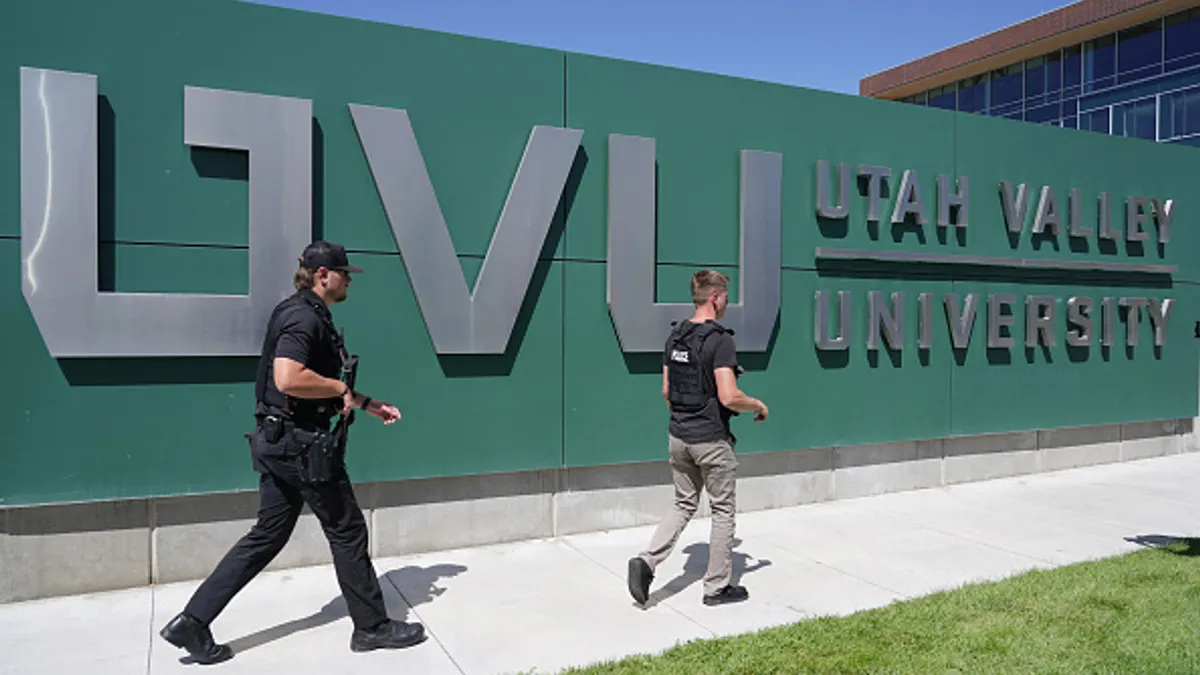Community colleges face mounting challenges. Since the Great Recession, states have pulled back their support, hurting the budgets of many two-year institutions. At the same time, a strong job market has pulled prospective students directly into the workforce, causing enrollments to drop nationwide.
Nonetheless, community colleges have a mission to provide learners with a low-cost, high-quality education, propelling them either to a four-year institution or helping them land a better job.
"Our jobs have never been more challenging, but they have never been more important," said Sandra Kurtinitis, chair of the American Association of Community Colleges' Board of Directors, to attendees at the organization's annual conference, held this week in Orlando, Florida. "This is indeed our time in the sun, and the ugly duckling that we once were from the wrong side of the ivory tower has indeed become the proverbial swan."
Throughout the conference, community college leaders shared how their institutions are working with fewer resources to fulfill their missions and reinvent the struggling sector. Here's what we learned about how two-year institutions are improving student outcomes and their own bottom lines.
Pivoting toward guided pathways
The concept of guided pathways is gaining traction as a way to help get students across the finish line at community colleges, where six-year graduation rates hover around 26%.
The idea behind the guided pathways model is simple: Students are more likely to complete a credential or transfer to a four-year institution if they have a clear roadmap of what courses they need to take, as well as supports along the way to make sure they stick to their plan.
Early adopters have shown promise, with some reporting that students are completing credit-bearing courses sooner and taking more courses per semester, according to the Community College Research Center. Those successes have prompted more than 250 community colleges to shift toward the model.
Among them is Harper College, a two-year public institution in Illinois that serves roughly 35,000 students. In the last few years, the college has begun implementing an advising model along the guided pathways track.
"This is indeed our time in the sun, and the ugly duckling that we once were from the wrong side of the ivory tower has indeed become the proverbial swan."

Sandra Kurtinitis
Board chair, American Association of Community Colleges
The college now uses a case-management system in which students work with an adviser to chart out which courses they plan to take each semester. Students can access the plan online at any time to see whether they are still on track.
So far, the changes appear to be paying off. More than three-fourths (78%) of Harper students who made an academic plan with their adviser in their first semester returned the next year, while only 58% of those who didn't make a plan came back.
Such data adds momentum to the growing pathways movement. "If we're going to really move the needle on student success, we need to reengage and radically rethink the whole college," said John Fink, senior research associate at the Community College Research Center.
Providing more wraparound services
Colleges are recognizing the supports they provide for students need to extend beyond academic help. Often, a students' education can be upended by experiencing food and housing insecurity or an unexpected expense, such as a car repair.
That was a problem college leaders at Monroe Community College, in New York, discovered when some of its students participated in a 2016 survey from the Wisconsin Hope Lab, which studies food and housing insecurity in colleges. More than half (53%) of surveyed Monroe students indicated that in the last 30 days they had run out of food and didn't have money to buy more, while 12% said they'd experienced housing insecurity in the last year.
"It's one thing to imagine, 'OK, a few students are challenged,'" said John Delate, Monroe's associate vice president of student services. "But when we dug deeper into the data, we realized it wasn't just a handful, it was a significant number of our population."
Monroe's numbers mirror those of community colleges nationwide. About 42% of surveyed community college students reported being food insecure in the last 30 days, and 46% said they'd experienced housing insecurity in the last 12 months, according to the latest survey by the Hope Lab.
To tackle those challenges, Monroe launched a campuswide effort to increase supports, which included establishing a food pantry, offering emergency loans and making sure staff and faculty know how to connect students with campus resources. The cash-strapped college also sought partners. In March, for instance, the charitable arm of grocer Wegmans announced it was donating $3 million to help the college combat food insecurity.
"Our competition is poverty. When you start looking at things through that lens, it changes everything."

Ric Baser
President, Northwest Vista College
So far, the changes have had a positive effect on the persistence and retention rates of students who used the resources, Monroe leaders said.
Other college execs echoed those experiences. "Our competition is poverty," said Ric Baser, president of Northwest Vista College, in Texas. "When you start looking at things through that lens, it changes everything."
Making hard budget choices
Common initiatives underway at community colleges — such as overhauling an advising system or bolstering student support services — generally don't come cheap. But most two-year institutions have found themselves short on resources after years of enrollment declines and cuts in public support.
College leaders spoke of the need to make hard decisions about where to focus their budget. For example, leaders at Mississippi Gulf Coast Community College now determine on an annual basis whether to keep each program. If students no longer get jobs after completing it, the program gets cut, explained Mary Graham, the college's president.
"That was a new concept a few years ago," Graham said. "You have to be fast and aggressive. You have to be efficient with a few dollars."
Other college leaders emphasized that reallocating resources can be necessary to survive. Mott Community College, for instance, was in financial trouble in 2014, when Beverly Walker-Griffea took the helm as its president.
For one, the college's main campus, in Flint, Michigan, was in the throes of a water crisis. But Mott was also dealing with one of the highest poverty rates in the nation, a rapidly declining population and lower levels of public support.
Walker-Griffea said she knew the college would have to make some tough cuts to restore its budget. The leadership stopped automatically filling open positions, cut down on the number of college-funded contractors and reduced its budget for student employees.
"You have to be fast and aggressive. You have to be efficient with a few dollars."

Mary Graham
President, Mississippi Gulf Coast Community College
Those changes have helped the college stabilize. Its general fund has increased from about $6.6 million in 2015 to $7.6 million in 2018, and it has been able to allocate funds to capital improvements and employee raises.
"This heavy lift for the past five years has meant that we can ask ourselves, 'Where do we want to be in 2021?'" Walker-Griffea said. "(It has allowed) us to strategically plan … for where we want to be and where we want to go."
Re-enrolling students who dropped out
As colleges feel the pain of years-long enrollment declines, more are looking to tap into growing markets such as adult learners. But some are also looking at bringing back the students who stopped attending.
"We don't have this unlimited pot of high school students," said Patricia Thompson, assistant vice chancellor of student financial aid at the State University of New York (SUNY). "We need to make sure we don't lose them somewhere in the process."
In 2014, SUNY teamed up with a federal loan servicer to send a message to students who had dropped out and had debt: If they re-enrolled in college, they could avoid defaulting on their student loans.
The effort worked. One out of five students who received the message re-enrolled, with the majority (78%) doing so at a SUNY campus. Moreover, the effort has helped the campus recover $8.7 million in lost tuition revenue.
SUNY leaders noted that such efforts can't stop when students re-enroll. The system's 64 institutions also ramp up their communications with the students who come back, sending them emails that point them to critical academic supports and share information on how to get involved with campus life.
Other colleges have similar efforts underway. In 2016, Pueblo Community College, in Colorado, launched a plan in which students who owed the institution $1,000 or less could have their debt forgiven if they returned and completed one semester.
"We know if we wrap our arms around these students ... they will succeed."

Patty Erjavec
President, Pueblo Community College
Since the program's rollout, more than 300 students have re-enrolled, of which more than half completed their degrees. What's more, the college has brought in nearly $350,000 in revenue from the effort.
Like SUNY, Pueblo keeps re-enrolled students on track by checking in with them periodically, helping them complete the FAFSA and monitoring their academic progress. Those efforts have helped the large majority (94%) of students pass their first semester.
"We know if we wrap our arms around these students ... they will succeed," said Pueblo President Patty Erjavec. "They will complete."














